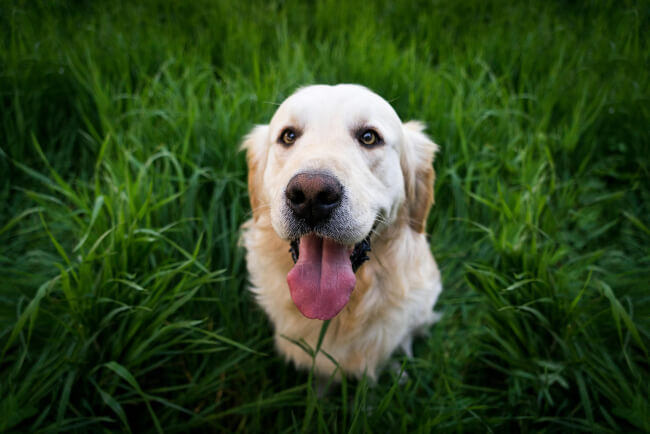If you’ve found yourself asking why your otherwise healthy, well-fed pup keeps snacking on your grass like it’s going out of fashion, you’re not alone. And no, you don’t have a cow in disguise. Dogs chewing grass is a common sight, and while it often causes more curiosity than concern, it can still leave you scratching your head. So, why do dogs eat grass?
Why Dogs Eat Grass

The short answer? There’s no single answer. It’s one of those dog behaviours that lands somewhere between instinct and impulse, with a few possible triggers behind it.
1. Old Habits Die Hard
Before they snuggled up on couches and wore party hats for birthdays, dogs were scrappy, scavenging hunters. Wild canines gobbled whatever they could catch, including the stomach contents of plant-eating prey. That meant roughage. Seeds. Greens. So it’s possible that today’s grass-snacking is a leftover impulse, passed down the line like your Nan’s tea set.
2. Bored and Looking for Trouble
When dogs are left to their own devices, they can be led to grazing on grass. Younger puppies or breeds that need a lot of stimulation, such as Kelpies or Border Collies, may be more likely to eat grass to pass the time.
3. Do a Gut Check
There’s a common tale that dogs eat grass to make themselves throw up. But that’s only true in some cases. While it’s possible a dog might instinctively reach for grass when feeling queasy, most studies have found that vomiting doesn’t usually follow. And in plenty of cases, dogs who weren’t sick to begin with just… graze, and move on.
4. Something’s Missing in the Bowl
Grass might also be your dog’s way of patching up a hole in their diet, particularly fibre. If they’re not getting enough plant matter or roughage, some dogs will go looking for it in the closest green patch they can find. That doesn’t mean your kibble is rubbish, but it’s worth considering whether their gut might be asking for a little more variety.
When It’s More Than Just a Quirk
Most dogs who nibble grass from time to time aren’t sounding any alarm bells. It’s a bit odd, sure, but plenty of odd behaviours come baked into dog ownership (rolling in fish guts comes to mind). Still, there are a few cases where grass-eating drifts from “mildly strange” to “something’s up.”
1. They Vomit Often After Eating Grass
If your dog vomits every now and then, it isn’t a big cause for panic. But if your dog routinely eats grass and then vomits, then it’s worth flagging. It could show signs of gut irritation, dietary sensitivity, or something worse that may need your vet’s help.
2. They’re Treating Your Lawn Like an All-You-Can-Eat Buffet
If your dog is just nibbling a few blades of grass here and there, it’s fine. But if he obsessively goes out to graze and doesn’t stop, it may signal something more. It can point to unmet needs, be it mental, physical or nutritional.
3. They’re Eating Treated Grass
This one matters most. If your dog’s chewing on lawns that have been sprayed with weedkiller, fertiliser, or other garden chemicals, they’re doing more than snacking, they’re ingesting toxins. If you suspect they’ve eaten chemically treated grass, it’s best to call your vet. Better safe than sorry.
How to Stop or Gently Reduce the Habit

If you’re keen to put an end to your dog’s lawn-munching habit, or at least rein it in, you’ve got a few tools at your disposal. No need to shame the behaviour, and no need to panic either. Just some simple tweaks that can make a big difference.
1. Make Walks More Interesting
A walk with plenty of sniffing around can be more tiring than a jog. Try scattering treats in the grass, change up your route, or bring an enriching toy. If your dog’s nibbling because they’re bored, you can redirect the energy into something other than grass.
2. Reassess Their Bowl
Talk to your vet about your dog’s current diet. Eating grass may point to a fibre deficiency, so adding a little more fibre to your dog’s diet can help.
3. Train a Solid “Leave It”
This one’s a lifesaver across the board, not just for grass. A strong “leave it” gives you a tool to interrupt the habit before it starts. Just be sure to reward the behaviour you do want, whether that’s looking up at you, walking on, or simply ignoring the grass altogether.
4. Mix Up the Scenery
If your dog seems obsessed with a particular grassy patch, then it may help to take a different route. Some dogs fixate on certain areas, so it helps to change up your walking path so your dog doesn’t develop a pattern or obsession.
Putting Your Mind at Ease About Grass-Eating Dogs
Dogs do weird things. They eat socks. They bark at the kettle. They find joy in chewing up sticks that taste like dirt. Grass-eating falls somewhere in that ballpark.
But if you’re finding it’s turning into a daily event, or your dog’s chewing looks less like curiosity and more like a job they’ve given themselves, that’s when it’s worth stepping in.
Keep their brain busy. Offer more variety in their meals. Teach a “leave it” that works before their nose hits the lawn. Above all, pay attention, every dog has their own reason, and their behaviour offers clues.
If something feels off, trust your gut and ring the vet. But if your dog is just the occasional grazer with no side effects? No need to panic, you’ve probably just got a pooch with strange taste.

Add your first comment to this post